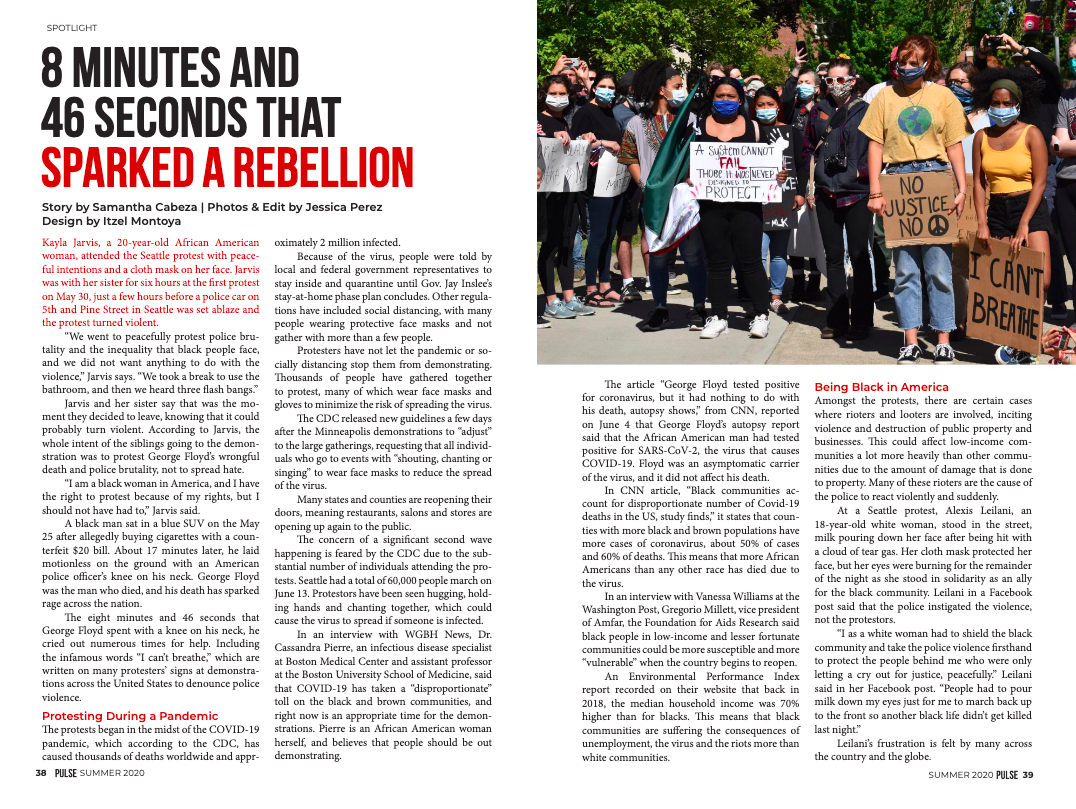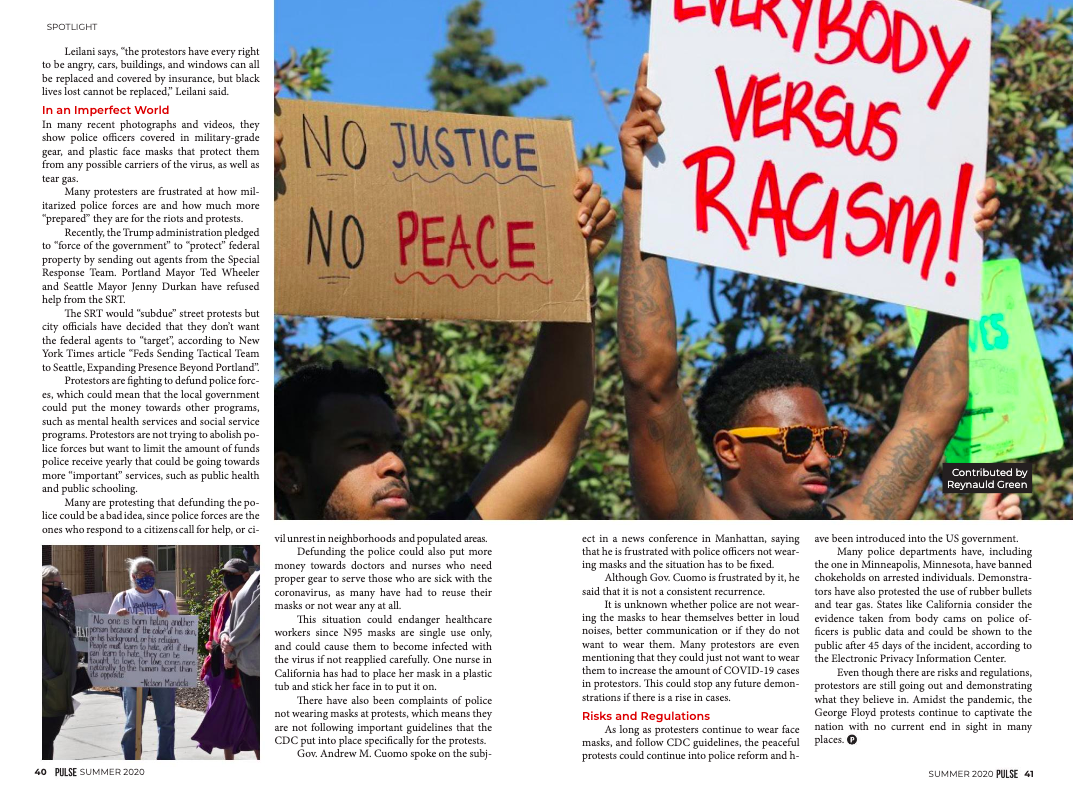8 Minutes and 46 Seconds that Sparked a Rebellion
Story by Samantha Cabeza | Photos & Edit by Jessica Perez | Design by Itzel Montoya
Kayla Jarvis, a 20-year-old African American woman, attended the Seattle protest with peaceful intentions and a cloth mask on her face. Jarvis was with her sister for six hours at the first protest on May 30, just a few hours before a police car on 5th and Pine Street in Seattle was set ablaze and the protest turned violent.
“We went to peacefully protest police brutality and the inequality that black people face, and we did not want anything to do with the violence,” Jarvis says. “We took a break to use the bathroom, and then we heard three flash bangs.”
Jarvis and her sister say that was the moment they decided to leave, knowing that it could probably turn violent. According to Jarvis, the whole intent of the siblings going to the demonstration was to protest George Floyd’s wrongful death and police brutality, not to spread hate.
“I am a black woman in America, and I have the right to protest because of my rights, but I should not have had to,” Jarvis said.
A black man sat in a blue SUV on the May 25 after allegedly buying cigarettes with a counterfeit $20 bill. About 17 minutes later, he laid motionless on the ground with an American police officer’s knee on his neck. George Floyd was the man who died, and his death has sparked rage across the nation.
The eight minutes and 46 seconds that George Floyd spent with a knee on his neck. He called out numerous calls for help. Including the infamous words “I can’t breathe,” which are written on many protesters’ signs at demonstrations across the United States to denounce police violence.
Protesting during a pandemic
The protests began in the midst of the COVID-19 pandemic, which according to the CDC, has caused thousands of deaths worldwide and approximately 2 million infected.
Because of the virus, people were told by local and federal government representatives to stay inside and quarantine until Gov. Jay Inslee’s stay-at-home phase plan concludes. Other regulations have included social distancing, with many people wearing protective face masks and not gather with more than a few people.
Protesters have not let the pandemic or socially distancing stop them from demonstrating. Thousands of people have gathered together to protest, many of which wear face masks and gloves to minimize the risk of spreading the virus.
The CDC released new guidelines a few days after the Minneapolis demonstrations to “adjust” to the large gatherings, requesting that all individuals who go to events with “shouting, chanting or singing” to wear face masks to reduce the spread of the virus.
Many states and counties are reopening their doors, meaning restaurants, salons and stores are opening up again to the public.
The concern of a significant second wave happening is feared by the CDC due to the substantial number of individuals attending the protests. Seattle had a total of 60,000 people march on June 13. Protestors have been seen hugging, holding hands and chanting together, which could cause the virus to spread if someone is infected
In an interview with WGBH News, Dr. Cassandra Pierre, an infectious disease specialist at Boston Medical Center and assistant professor at the Boston University School of Medicine, said that COVID-19 has taken a “disproportionate” toll on the black and brown communities, and right now is an appropriate time for the demonstrations. Pierre is an African American woman herself, and believes that people should be out demonstrating.
The article “George Floyd tested positive for coronavirus, but it had nothing to do with his death, autopsy shows,” from CNN, reported on June 4 that George Floyd’s autopsy report said that the African American man had tested positive for SARS-CoV-2, the virus that causes COVID-19. Floyd was an asymptomatic carrier of the virus, and it did not affect his death.
Floyd was tested positive for the virus on April 3, according to Carol Cryst at WebMD. Since positive test results can last for weeks, on May 26 a post-mortem nasal-drip swab confirmed the result. Floyd was a part of the low-income black community.
In CNN article, “Black communities account for disproportionate number of Covid-19 deaths in the US, study finds,” it states that counties with more black and brown populations have more cases of coronavirus, about 50% of cases and 60% of deaths. This means that more African Americans than any other race has died due to the virus.
In an interview with Vanessa Williams at the Washington Post, Gregorio Millett, vice president of Amfar, the Foundation for Aids Research said black people in low-income and lesser fortunate communities could be more susceptible and more “vulnerable” when the country begins to reopen.
An Environmental Performance Index report recorded on their website that back in 2018, the median household income was 70% higher than for blacks. This means that black communities are suffering the consequences of unemployment, the virus and the riots more than white communities.
Being Black in America
Amongst the protests, there are certain cases where rioters and looters are involved, inciting violence and destruction of public property and businesses. This could affect low-income communities a lot more heavily than other communities due to the amount of damage that is done to property. Many of these rioters are the cause of the police to react violently and suddenly.
At a Seattle protest, Alexis Leilani, an 18-year-old white woman, stood in the street, milk pouring down her face after being hit with a cloud of tear gas. Her cloth mask protected her face, but her eyes were burning for the remainder of the night as she stood in solidarity as an ally for the black community. Leilani in a Facebook post said that the police instigated the violence, not the protestors.
“I as a white woman had to shield the black community and take the police violence firsthand to protect the people behind me who were only letting a cry out for justice, peacefully.” Leilani said in her Facebook post. “People had to pour milk down my eyes just for me to march back up to the front so another black life didn’t get killed last night.”
Leilani’s frustration is felt by many across the country and the globe.
Leilani says, “the protestors have every right to be angry, cars, buildings, and windows can all be replaced and covered by insurance, but black lives lost cannot be replaced,” Leilani said.
In an imperfect world
In many recent photographs and videos, they show police officers covered in military- grade gear, and plastic face masks that protect them from any possible carriers of the virus, as well as tear gas.
Many protesters are frustrated at how militarized police forces are and how much more “prepared” they are for the riots and protests.
Protestors are fighting to defund police forces, which could mean that the local government could put the money towards other programs, such as mental health services and social service programs. Protestors are not trying to abolish police forces but want to limit the amount of funds police receive yearly that could be going towards more “important” services, such as public health and public schooling.
Many are protesting that defunding the police could be a bad idea, since police forces are the ones who respond to a citizen's call for help, or civil unrest in neighborhoods and populated areas.
Defunding the police could also put more money towards doctors and nurses who need proper gear to serve those who are sick with the coronavirus, as many have had to reuse their masks or not wear any at all.
This situation could endanger healthcare workers since N95 masks are single use only, and could cause them to become infected with the virus if not reapplied carefully. One nurse in California has had to place her mask in a plastic tub and stick her face in to put it on.
There have also been complaints of police not wearing masks at protests, which means they are not following important guidelines that the CDC put into place specifically for the protests.
Gov. Andrew M. Cuomo spoke on the subject in a news conference in Manhattan, saying that he is frustrated with police officers not wearing masks and the situation has to be fixed. Although Gov. Cuomo is frustrated by it, he said that it is not a consistent recurrence.
It is unknown whether police are not wearing the masks to hear themselves better in loud noises, better communication or if they do not want to wear them. Many protestors are even mentioning that they could just not want to wear them to increase the amount of COVID-19 cases in protestors. This could stop any future demonstrations if there is a rise in cases.
Risks and regulations
As long as protesters continue to wear face masks, and follow CDC guidelines, the peaceful protests could continue into police reform and have been introduced into the US government.
Many police departments have, including the one in Minneapolis, Minnesota, have banned chokeholds on arrested individuals. Demonstrators have also protested the use of rubber bullets and tear gas. States like California consider the evidence taken from body cams on police officers is public data and could be shown to the public after 45 days of the incident, according to the Electronic Privacy Information Center.
Even though there are risks and regulations, protestors are still going out and demonstrating what they believe in. Amidst the pandemic, the George Floyd protests continue to captivate the nation with no current end in sight in many places.















